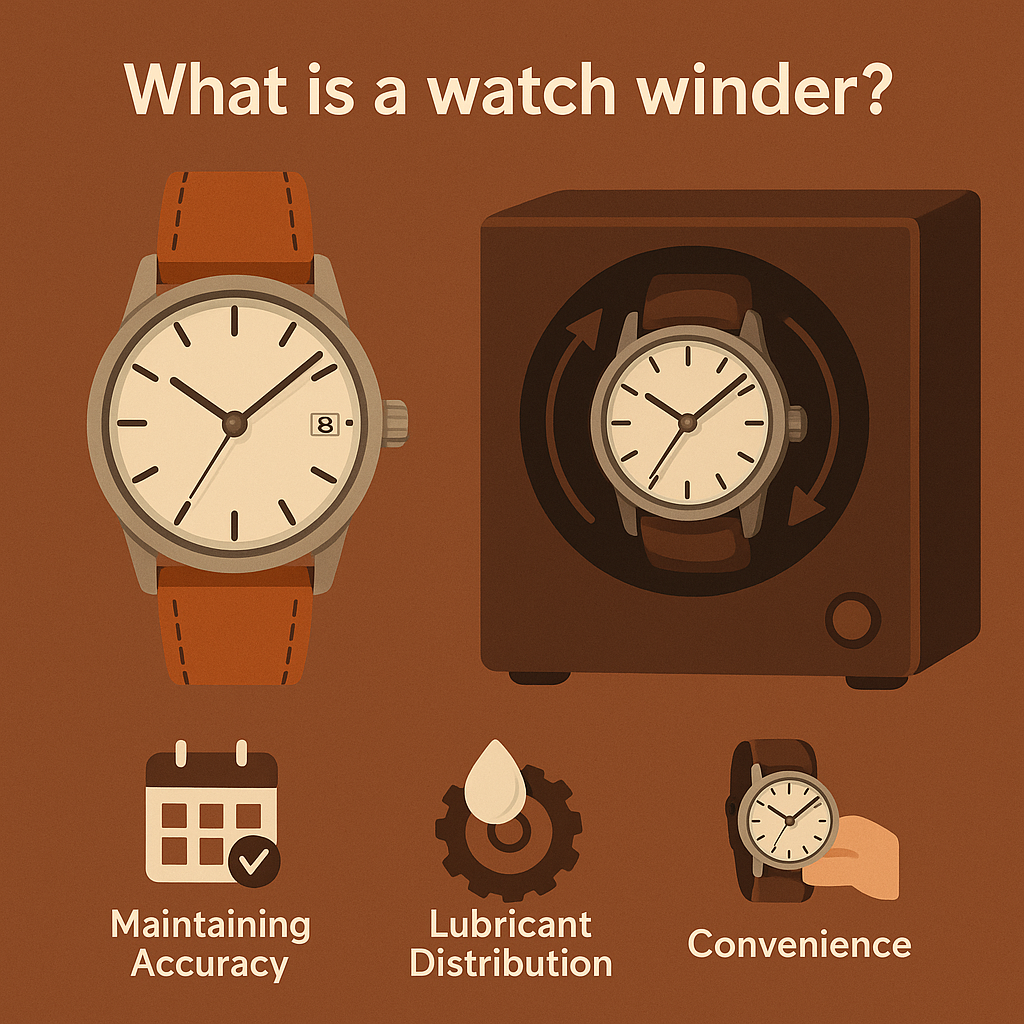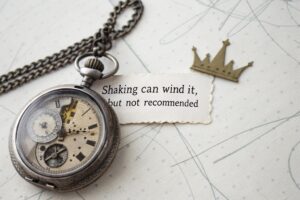
What is a watch winder?
Are your automatic watches always stopping? Resetting the time and date constantly is frustrating. A watch winder keeps them running smoothly, ready to wear anytime.
A watch winder is a device that keeps automatic watches wound when they are not being worn. It mimics the motion of the human wrist, rotating the watch gently to keep the mainspring tensioned1 and the movement running.
You might wonder if this device is just a fancy accessory or something genuinely useful for your timepieces. Let’s explore what a watch winder does and whether it’s right for you. Understanding its function helps you decide if it meets your needs.
What is the purpose of a watch winder?
Tired of your automatic watch dying? Setting the time and complications repeatedly is a hassle. A watch winder solves this by keeping your watch powered and accurate.
The main purpose of a watch winder is to keep an automatic watch running when it’s not on your wrist. This ensures the time, date, and any other complications remain accurate, saving you the trouble of resetting them.
Let’s dive deeper into why this matters. Keeping an automatic watch running involves more than just convenience. It relates to the watch’s mechanism and its long-term care. An automatic watch relies on the movement of your arm to wind itself via a weighted rotor. When you take it off, it has a power reserve2, usually lasting 36-72 hours. If it sits longer than that, it stops. A winder prevents this stop-start cycle.
Key Functions Explained
- Maintaining Accuracy: For watches with complex features like perpetual calendars or moon phases, resetting them can be complicated. A winder keeps everything synchronized.
- Lubricant Distribution: Some believe constant movement helps distribute lubricants evenly within the watch mechanism, potentially prolonging service intervals. While modern lubricants are very stable, keeping parts moving prevents thickening in one spot.
- Convenience: It’s simply easier to pick up a watch that’s already running and set correctly, especially if you rotate through several watches.
| Here’s a simple breakdown: | Feature | Manual Reset Required (No Winder) | Watch Winder Use | Benefit of Winder |
|---|---|---|---|---|
| Timekeeping | Yes, after power reserve runs out | No, watch keeps running | Ready to wear | |
| Complications | Yes, potentially complex reset | No, functions stay accurate | Avoids tedious adjustments | |
| Mechanism | Stops and starts frequently | Runs continuously | Consistent operation | |
| Lubrication | Stationary when stopped | Lubricants potentially circulate | May aid long-term health |
As a manufacturer (GOOCHY), we see many collectors and retailers value winders for preserving the function and readiness of their automatic timepieces. It’s about maintaining the investment.
Do I really need a watch winder?
Own an automatic watch but unsure about a winder? You might wonder if it’s essential or just a luxury. Deciding depends on your watch habits and collection.
Whether you need a watch winder depends. If you wear your automatic watch daily, probably not. If you own multiple automatics or wear yours infrequently, a winder offers significant convenience and helps keep complex watches set correctly.

Let’s look closer at the factors determining if a winder is a worthwhile investment for you. It’s not a simple yes or no answer; it’s about practicality matched to your lifestyle and collection. We often discuss this with clients, from individual collectors to large retailers deciding on accessories for their customers.
Factors to Consider
- Watch Type: Winders are only useful for automatic (self-winding) watches. They do nothing for quartz or manual-wind watches.
- Number of Watches: If you own only one automatic watch and wear it most days, your wrist movement is sufficient. If you have two or more automatics that you rotate, a winder keeps the ones you’re not wearing ready to go.
- Wearing Frequency: If you wear your automatic watch less than every couple of days, its power reserve will likely run out. A winder prevents this.
- Watch Complications: Watches with perpetual calendars, moon phases, or annual calendars are much more convenient to keep running, as resetting them can be complex and time-consuming.
- Personal Preference: Some people simply enjoy the convenience and the display aspect of a watch winder.
Here’s a quick guide:
| Scenario | Winder Recommended? | Reason |
|---|---|---|
| Own one automatic, wear it daily | No | Wrist motion sufficient |
| Own multiple automatics, rotate wear | Yes | Keeps unworn watches running and set |
| Wear automatic infrequently | Yes | Prevents stopping and needing resets |
| Watch has complex complications (calendar) | Yes | Avoids difficult or time-consuming resets |
| Enjoy convenience and display | Yes | Personal preference, keeps watch ready |
| Own only quartz/manual-wind watches | No | Winder serves no function for these types |
From my experience working with brands and collectors, the need often grows with the collection size. A client starting with one automatic might not need one, but once they acquire a second or third, the winder becomes almost essential for practicality.
Is it OK to leave a Rolex on a watch winder?
Worried about your valuable Rolex on a winder? Concerns about potential damage or over-winding are common. You want assurance that using a winder is safe for your luxury watch.
Yes, it is generally safe and acceptable to leave a Rolex on a quality watch winder. Modern Rolex watches are robust. Use a winder with correct Turns Per Day (TPD) and directional settings recommended for the specific Rolex movement.

Using a watch winder for a Rolex, or any high-end automatic watch, requires understanding the watch’s needs and the winder’s capabilities. It’s not about just putting it on any rotating device. Precision matters. At GOOCHY, we emphasize programmable settings in our winders precisely for this reason – to cater safely to valuable timepieces like Rolex.
Ensuring Safety for Your Rolex
- Correct TPD: Rolex movements typically require around 650 TPD. Setting a winder too high could theoretically cause unnecessary wear over the very long term, although modern watches have mechanisms to prevent over-winding. Setting it too low means the watch might still stop.
- Correct Direction: Most modern Rolex movements wind bidirectionally (clockwise and counter-clockwise). Setting the winder to bidirectional ensures optimal winding. Some older models might have specific directional needs. Always check your watch’s specifications or consult a reliable database.
- Winder Quality: A high-quality winder provides smooth, controlled rotation and reliable settings. Cheaper winders might have inconsistent rotation or motors that generate magnetism, which is best avoided. Our winders use shielded, silent Japanese motors known for their reliability and low magnetism.
- Rest Periods: Good winders operate intermittently, rotating for a period and then resting. This mimics natural wear more closely than constant rotation and prevents any theoretical risk of excessive wear.
Here’s a general guideline for Rolex (always double-check specific model requirements):
| Feature | Recommendation for Rolex | Why it Matters |
|---|---|---|
| TPD Setting | ~650 TPD | Matches Rolex automatic winding system needs |
| Direction | Bidirectional (Clockwise & CCW) | Efficient winding for most modern Rolex movements |
| Winder Quality | High (programmable, shielded) | Ensures safety, prevents magnetism, ensures accuracy |
| Operation Mode | Intermittent (with rest cycles) | Mimics natural wear, prevents constant stress |
Leaving a Rolex on a properly configured, high-quality winder is standard practice for many owners and dealers. It keeps the watch ready and doesn’t harm the movement when used correctly. Concerns usually arise from using low-quality winders or incorrect settings.
What is the disadvantage of a watch winder?
Considering a watch winder but worried about downsides? You might fear potential harm to your watch or see it as an unnecessary expense. Understanding the drawbacks helps make an informed choice.
Potential disadvantages include the initial cost, the slight possibility of increased wear if used improperly or with a low-quality winder, and minor electricity consumption. For most users with quality equipment, these are minimal concerns compared to the benefits.

While watch winders offer great convenience, it’s fair to consider any potential drawbacks. As manufacturers, we aim to minimize these through design and quality, but buyers should be aware of what to look for and potential pitfalls, especially with cheaper options.
Exploring Potential Downsides
- Cost: A good quality watch winder is an investment. Prices range significantly, but reliable units with programmable settings and quiet motors cost more than basic models. This initial expense is the most obvious disadvantage.
- Potential for Wear (Myth vs. Reality): Some argue that keeping a watch running constantly causes more wear than letting it stop. However, watch movements are designed to run. Starting and stopping frequently might also cause wear. The key issue isn’t constant running, but how it runs. A cheap winder with jerky movements or incorrect TPD could potentially cause more harm than good. A quality winder with smooth rotation and correct settings mitigates this concern. Modern lubricants are also very stable.
- Electricity Consumption: A watch winder uses electricity, although the amount is typically very small, comparable to a digital clock. It’s unlikely to significantly impact your energy bill but is still a running cost.
- Noise: Low-quality winders can be noisy due to cheap motors, which can be annoying, especially in a bedroom or quiet office. Investing in a winder with silent motors, like the Japanese motors we use at GOOCHY, eliminates this issue.
- Incorrect Settings: Using the wrong TPD or direction settings could potentially strain the watch mechanism over time or fail to keep it wound. User error or lack of programmability on basic models can be a disadvantage.
Let’s summarize these points:
| Potential Disadvantage | Mitigation with Quality Winder (e.g., GOOCHY) | Reality Check |
|---|---|---|
| Initial Cost | Focus on long-term value, durability, features | A necessary investment for quality and safety |
| Wear and Tear | Smooth rotation, correct TPD/direction, rest cycles | Minimal risk with proper settings and quality unit |
| Electricity Use | Efficient motors | Very low consumption, negligible cost |
| Noise | High-quality silent motors (e.g., Japanese Mabuchi) | Quality winders are virtually silent |
| Incorrect Settings | Programmable TPD/direction, clear instructions | User needs to set it correctly for their watch |
For our B2B clients, like luxury dealers (Thomas Weber) or gift companies (Sarah Chen), the reliability and quiet operation of our winders are paramount. They understand that mitigating these potential disadvantages is key to satisfying their own discerning customers. The main disadvantage truly lies in choosing a poor-quality device rather than the concept of a winder itself.
Conclusion
In short, a watch winder keeps automatic watches running when off the wrist. It offers convenience, maintains accuracy, and is safe for watches like Rolex when used correctly.
You may also be interested in:

How long does it take to fully wind an automatic watch?
Do you have an automatic watch? Are you wondering how long it takes to wind

What Happens If You Leave Your Watch on a Winder?
Are you curious about using a watch winder? Maybe you are worried about the effects